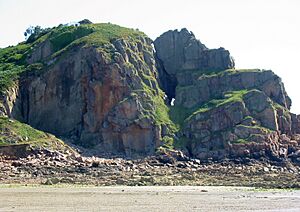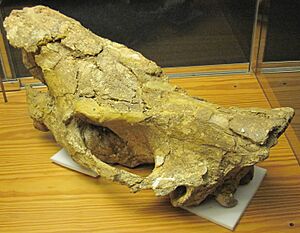La Cotte de St Brelade facts for kids

La Cotte de St Brelade
|
|
| Alternative name | Lé Creux ès Fées |
|---|---|
| Location | St Brelade |
| Region | Jersey |
| Coordinates | 49°10′32″N 2°11′18″W / 49.17556°N 2.18833°W |
| History | |
| Periods | Paleolithic |
| Associated with | Neanderthals |
La Cotte de St Brelade is an amazing ancient site located in Saint Brélade, Jersey. It's a Paleolithic (Stone Age) cave where early humans lived a very long time ago. The word Cotte means "cave" in Jèrriais, which is the local language of Jersey. People also call this cave Lé Creux ès Fées, which means "The Fairies' Cave."
Neanderthals, a type of early human, lived in La Cotte at different times. They were here from about 250,000 years ago until after 48,000 years ago. This makes it the earliest known place where early humans lived in the Channel Islands. It might also be one of the last places Neanderthals lived in northwestern Europe. It's the only site in the British Isles where scientists have found late Neanderthal bones.
Back then, the sea level was lower than it is today. Jersey was actually connected to Normandy, which is part of France. La Cotte would have been a tall landmark on a dry plain. This plain linked Jersey to the French mainland. It was only after the last Ice age that the sea rose. It slowly separated Guernsey, then Jersey, and finally the Écréhous from the mainland.
Discovering Ancient Fire
Scientists have found signs of fire at La Cotte. This shows that the early people living there knew how to use fire. The oldest dates for things found at the site come from burnt flint. These dates are about 238,000 years old. Scientists use a method called thermoluminescence dating to find out how old these burnt flints are.
How Life Changed Over Time
The ancient tools found at La Cotte cover a huge period, almost 200,000 years! This means we can see how the people living there changed over time.
The oldest stone tools, from about 240,000 to 200,000 years ago, are quite simple. But after 200,000 years ago, the tools became much more advanced. People started using a special way to make tools called the Levallois technique. This method made tools more efficient. They also reused and sharpened their tools many times.
Around 180,000 years ago, something very interesting happened. Scientists found two piles of animal bones. These piles were made of selected parts of mammoths and woolly rhinoceros. It looks like the Neanderthals butchered these huge animals. Then, they dragged the best parts under a rock overhang. These discoveries show how the Neanderthals' hunting and survival skills improved over time.
Exploring La Cotte: A Timeline of Discoveries
People have been digging and studying La Cotte since around 1910.
- Early Excavations (1910-1914): Robert Ranulph Marett was an early archaeologist who worked at La Cotte. He found some hominid (early human) teeth and other signs that Neanderthals lived there. In 2013, new tests showed these teeth were between 100,000 and 47,000 years old.
- Cambridge University Digs (1960s-1970s): Later, archaeologists from Cambridge University did more excavations. They found important remains of large Ice Age animals, called Pleistocene mammals. This included a big pile of bones and teeth from woolly mammoths and woolly rhinoceroses. Interestingly, Prince Charles (who is now King Charles III) even helped with these digs when he was a student!
- Hunting Theories: In 1980, a researcher named Katharine Scott suggested that Neanderthals at La Cotte hunted mammoths by scaring them off nearby cliffs. However, this idea has been debated by other scientists.
- New Discoveries (2010-Present): In 2010, a new team of scientists started digging again. They are from places like UCL, The British Museum, and the University of Southampton. These ongoing digs have found even newer layers of archaeological finds. They show that people were still at the site even after 47,000 years ago.






